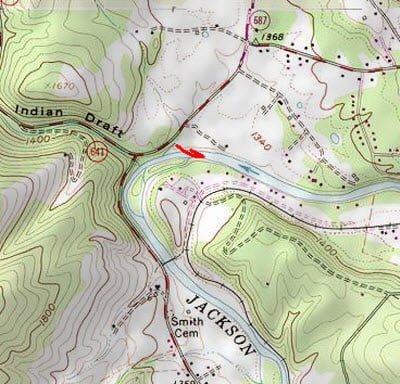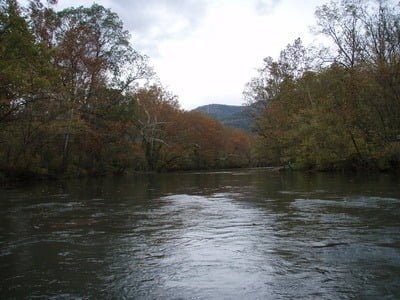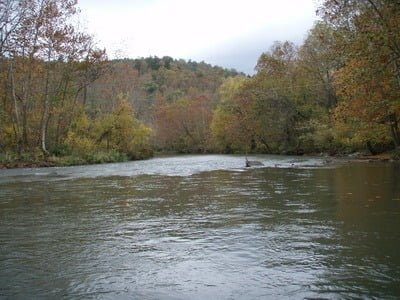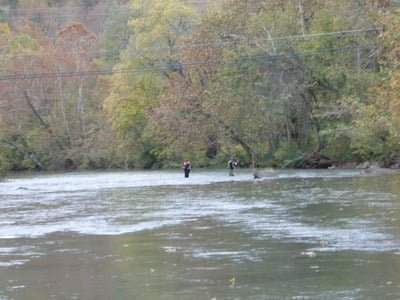After being run out the of the river at Smith Bridge based on “posted” signs on the riverbanks, I pointed the truck south and headed to the next access point — Indian Gap. Like Smith Bridge, there is a well-developed parking area with a kiosk containing relevant regulations and information. It also cautions you about being careful where you fish based on the confusing property rights along the riverbanks. After the experience at Smith, I looked carefully up and down the stream to see if there were any signs limiting access posted along the river. Thankfully, there were none. As far as I could see – no signs dotting the river’s edge.
I chatted a little bit with two fly fishermen who were about to start a canoe trip and asked them if they fished here often. They indicated that while you do have to watch the landowner rights, their experience was that if you ask permission, it is routinely granted. That’s nice to know, but that leads to the challenge of figuring out which of the houses dotting the landscape controls access to the part of the river you want to fish. It would certainly be obnoxious to have to knock on 15 doors to get access to a quarter mile of the river.
Anyway, I thanked them for the information and began fishing upstream. They entered the water behind me to fish a bit before beginning their canoe voyage downstream. I continued to use nymphs since they had been successful up at Smith Bridge. Unfortunately, there was no joy in this spot. With the water remaining milky, I wasn’t really motivated to expend much energy since I still wanted to visit Second Creek over in West Virginia. So, after a halfhearted attempt to wade upstream, I returned to the parking lot.
My short visit was enough to get a sense of the river. It was a little tighter than Smith Bridge, offered equally good structure, and was easily wadable. The riverbed looked like it had more rock ledges and fewer boulders than the area around Smith Bridge. Please take this with a grain of salt since, given the clouded condition of the water, I could not get a clear view of the bottom. Instead, I’m reporting on what I could feel with my feet shuffling upstream. Unlike the eastern Virginia Rivers like the Rapidan and the Rappahannock, there was no sand in evidence anywhere. The bottom was totally rocky, which bodes well for fantastic insect density. On this late October day, the water was running a crisp 55°.
When I returned to the launch point, I could see the canoe guys off in the distance. They had pulled the canoe to the side at the next bend downstream and were wading again. On the drive south from Indian Gap, I noted a nice spot at that bend that continued downstream beyond where the canoe guys had stopped. In fact, the road runs right next to the river for a mile and I did not see any posted signs that would restrict access. From the road, it looks uniformly fast, reasonably shallow and wadable. In addition to some high risk, tight parking spots on the right-hand side, I noticed one pull off near a foot bridge that stretched across the river. Don’t get excited about that one since there was a posted sign in evidence.

Jackson River Trout Fishing Bottom line: Indian Gap merits a return trip. It’s close enough to Smith Bridge to be able to use a bike shuttle. Leave your bike at Indian gap, launch from Smith and then bike back to your vehicle
Getting There: Take exit 16A for US-60W/US-220N from I64. Follow it to the left onto Jackson River Road (Rt 687). Follow Jackson River road and you will see the turn to Indian Gap.
Google Local Coordinates: 37.868878,-79.988714
Secrets Revealed? No. This is a very public location that is documented in the following places:
Virginia VDGIF
Flyfisher’s Guide to Virginia
Virginia Trout Streams
Virginia Blue-Ribbon Streams
Fly Fishing Virginia
Mid-Atlantic Budget Angler
Date Fished: 10/12/2009
Tell a friend about this article by clicking on this link

Upstream from the access point

Downstream from the access point

The canoe guys fishing the riffle below the rapid at the access point
Unless stated otherwise, this article was authored by Steve Moore


